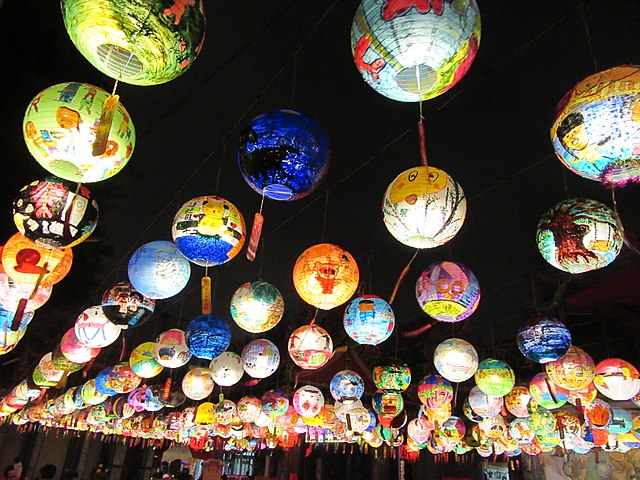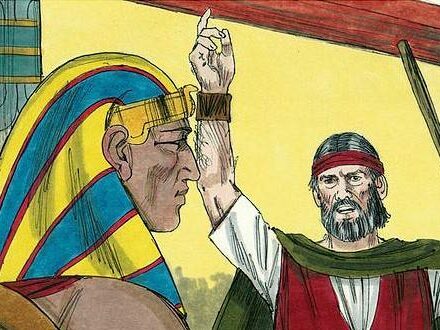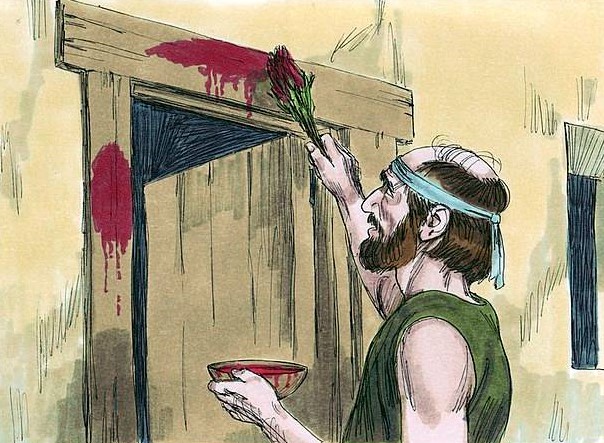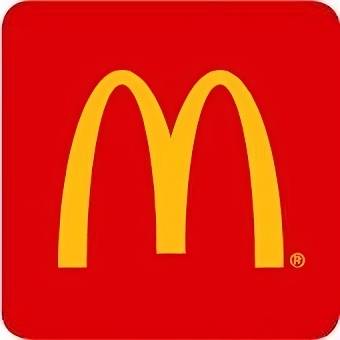The Lantern Festival (元宵節, 元宵节, Yuánxiāo jié), or Shangyuan Festival (上元節, 上元节, Shàngyuán jié) concludes the Chinese New Year celebrations. The Lantern Festival is celebrated on the first full moon in the new year of the traditional Chinese calendar. The Chinese calendar, and other Asian calendars, combines lunar months and solar years into a lunisolar calendar. The twelve revolutions of the moon around the earth take 354 days. So lunisolar calendars add extra leap-months to specific years over 19 years. Thus, the lunar months and solar years synchronize over this repeating period.

-Zest, CC BY-SA 4.0, via Wikimedia Commons
The climax of the lantern festival involves going out at night carrying paper lanterns and solving riddles on the lanterns. These often contain messages of good fortune, family reunion, abundant harvest, prosperity and love.
Origins of Ancient New Year Festivals
Various legends explain the origins of the Lantern Festival. One tells how the Jade Emperor, angered over the killing of his favorite bird, intended to destroy the people with fire. The people under the judgment of the Jade Emperor decided to light red lanterns, fireworks, and bonfires. Then the angels sent to destroy them would be tricked into thinking that the fire judgment had already occurred. This plan worked and the people escaped from the judgment. Other legends also recount how lanterns on the full moon of the first month turned aside a divine judgment.

Imperial Ming Court, Public domain, via Wikimedia Commons
The Hebrew calendar, also a lunisolar calendar, is as ancient as the Chinese calendar. It likewise marks a festival on the first full moon of their year. This festival, initiated over 3500 years ago, does not involve solving riddles. Instead, God established it as a riddle for all peoples to solve. It took 1500 years for the riddle’s solution to come about. It showed how liberation from karma and death would be achieved for all peoples.
In this article we go over this festival, the riddle it poses, its solution, and why this affects your life. We have been going through the records of the Ancient Hebrew scriptures and have now come to the Passover Festival.
The Exodus Passover
We last looked at Abraham’s sacrifice, which occurred 4000 years ago. His descendants through his son Isaac, called Israelites, had become a vast people. But the Egyptians had also enslaved them.
We now come to the dramatic struggle taken up by the Israelite leader Moses. The book of Exodus in the Hebrew Bible records this event. It records how Moses led the Israelites out of Egyptian slavery 500 years after Abraham, around 3500 years ago. The Creator God commanded Moses to confront the Pharaoh (ruler) of Egypt. This resulted in mighty conflicts between them which had brought nine plagues, or disasters, on Egypt. But Pharaoh had still not agreed to let the Israelites go free. So God was going to bring about a 10th and final plague. Click to read the complete account of the 10th Plague. Here, we highlight the Passover riddle and its solution.

Sweet Publishing, CC BY-SA 3.0, via Wikimedia Commons

Passover Details…
It starts with this upcoming event defining the start of their year:
1 The Lord said to Moses and Aaron in Egypt, 2 “This month is to be for you the first month, the first month of your year.
Exodus 12:1-2
Then the Israelites were to:
3 Tell the whole community of Israel that on the tenth day of this month each man is to take a lamb for his family, one for each household.
Exodus 12:3
God then instructed them to do something very strange with these lambs, which formed the riddle of the festival. It also occurred on the full moon of that first month, just like the Lantern Festival.
6 Take care of them until the fourteenth day of the month, when all the members of the community of Israel must slaughter them at twilight.
Exodus 12:6
On the evening of the 14th, through the 15th of that month, they were to slaughter the lambs.
7 Then they are to take some of the blood and put it on the sides and tops of the doorframes of the houses where they eat the lambs.
Exodus 12:7
God decreed that for the 10th plague that an Angel (Spirit) of Death would pass through all houses across Egypt. Every firstborn son in each house across the entire land would die on that specific night. However, those who remained in houses with sacrificed lamb’s blood painted on the doorposts would live. Pharaoh’s doom, if he did not paint lamb’s blood on his door, would be to lose his son and heir. Every Egyptian family would lose their firstborn son if they did not paint the sacrificed lamb’s blood on their doorframes. Egypt faced a national disaster.

Sweet Publishing, CC BY-SA 3.0, via Wikimedia Commons
But God promised that in all houses with sacrificed lamb’s blood painted on the doorframes that everyone inside would live. The Angel of Death would pass over that house. So they called that day Passover (since death passed over all houses with lamb’s blood painted on them).
The Passover Riddle

Rijksmuseum, CC0, via Wikimedia Commons
Many assume that the blood on the doors was a sign for the Angel of Death. But notice the curious detail taken from the account written 3500 years ago:
“…I am the Lord. 13 The blood [of the Passover lamb] will be a sign for you on the houses where you are, and when I see the blood, I will pass over you.”
Exodus 12:12-13
God looked for the blood on the door, and when He saw it Death would pass over. But the blood was not a Sign for God. It says quite clearly, that the blood was a ‘sign for you’ – the people. It is also a Sign for all of us who read this account.
But what is it a sign for? This forms the Passover Riddle.
Afterwards the LORD commanded them to:
24 “Obey these instructions as a lasting ordinance for you and your descendants. 25 When you enter the land that the Lord will give you as he promised, observe this ceremony. 26 And when your children ask you, ‘What does this ceremony mean to you?’ 27 then tell them, ‘It is the Passover sacrifice to the Lord, who passed over the houses of the Israelites in Egypt and spared our homes when he struck down the Egyptians.’”
Exodus 12:24-27

God commanded the Israelites to continue celebrating Passover on the 14th – 15th of the first month every year. The Jewish calendar, being a lunisolar calendar like the Chinese, is different from the Western calendar. So the day of the festival changes each year of the Western calendar. But to this day, 3500 years later, Jewish people continue to celebrate Passover on the same date of their year. They do so in memory of this event and in obedience to that command given then.
Passover Riddle Solved 2000 Years Later
But the riddle remains: In what way was the blood a sign for us? In tracking this festival through history we can note something quite extraordinary. It comes 1500 years after that first Passover. You can notice this in the Gospel which records the details of the trial of Jesus:
28 Then the Jewish leaders took Jesus from Caiaphas to the palace of the Roman governor. By now it was early morning, and to avoid ceremonial uncleanness they did not enter the palace, because they wanted to be able to eat the Passover.
John 18:28
39 But it is your custom for me to release to you one prisoner at the time of the Passover. Do you want me to release ‘the king of the Jews’?”
John 18:39
In other words, Jesus was arrested and crucified right on the Passover day of the Jewish calendar. One of the titles given to Jesus was:
29 The next day John saw Jesus coming toward him and said, “Look, the Lamb of God, who takes away the sin of the world!
John 1:29
Here we see how the Passover becomes a Sign to us all. Jesus, the ‘Lamb of God’, was crucified (i.e. sacrificed) on the very same day of the year that the Jews sacrificed a lamb in memory of the first Passover that had occurred 1500 years before.
What Signs Do
Now think for a minute about what ‘signs’ do. You can see some signs below:

Shazz, Esteban, CC BY-SA 3.0, via Wikimedia Commons

Narjesm, CC BY-SA 4.0, via Wikimedia Commons

Yann Caradec, CC BY-SA 2.0, via Wikimedia Commons
The Dharmachakra is a Buddhist Sign. We do not just see an 8-spoked wheel since those who know the meaning of the sign recognize it as a symbol of Buddha’s teachings. Taking a minute to consider commercial signs, the sign of the ‘Golden Arches’ makes us think about McDonalds. The ‘√’, or ‘Swoosh’, sign on Rafael Nadal’s headband is the sign for Nike. Nike wants us to think of them when we see this sign on Nadal.
Signs are pointers in our minds to direct our thinking to the desired object.
The Signs Pointing to Jesus
The Passover account in the Hebrew Scriptures of Exodus explicitly said that the Sign was for the people, not for the Creator God (though He still looked for the blood and would pass over the house if he saw it). As with all signs, what did He want us to think of when we look to Passover? With the remarkable timing of lambs sacrificed on the same day as Jesus, the sign points to the sacrifice of Jesus, the Lamb of God.
It works in our minds as shown below. The sign points us to the sacrifice of Jesus:

Passover Sign Pointing to Day in the Year
In that first Passover, the lambs were sacrificed and the blood spread so the people could live. Jesus, the Lamb of God, was also sacrificed and his blood spilt so we could receive life. The Passover points to Jesus, in that these sacrifices happened on the same day of the year. The timing of Jesus’ sacrifice with that of Passover solves the Passover riddle.
Abraham’s Sign Pointing to Location
In Abraham’s sacrifice, the location where Abraham offered his his son was Mount Moriah. A lamb died so Abraham’s son could live.

Mount Moriah was the very same place where Jesus was sacrificed. That was a Sign to make us ‘see’ the meaning of his death by pointing to the location. In the Passover we find another pointer to Jesus’ sacrifice – by pointing to the same day in the year. A lamb sacrifice is used both times to point to the sacrifice of Jesus. In two different ways (location and timing), the most important events in the sacred Hebrew scriptures directly point to Jesus. I cannot think of any other person in history whose death is foreseen so far into the future by such clear parallels in such dramatic fashion. Can you?
God gave these signs so that we can have confidence that the sacrifice of Jesus really was planned and ordained by God. They illustrate how the sacrifice of Jesus saves us from Karma.
The next event we look at, the giving of the Ten Commandments, shows us why we need receive his sacrifice.